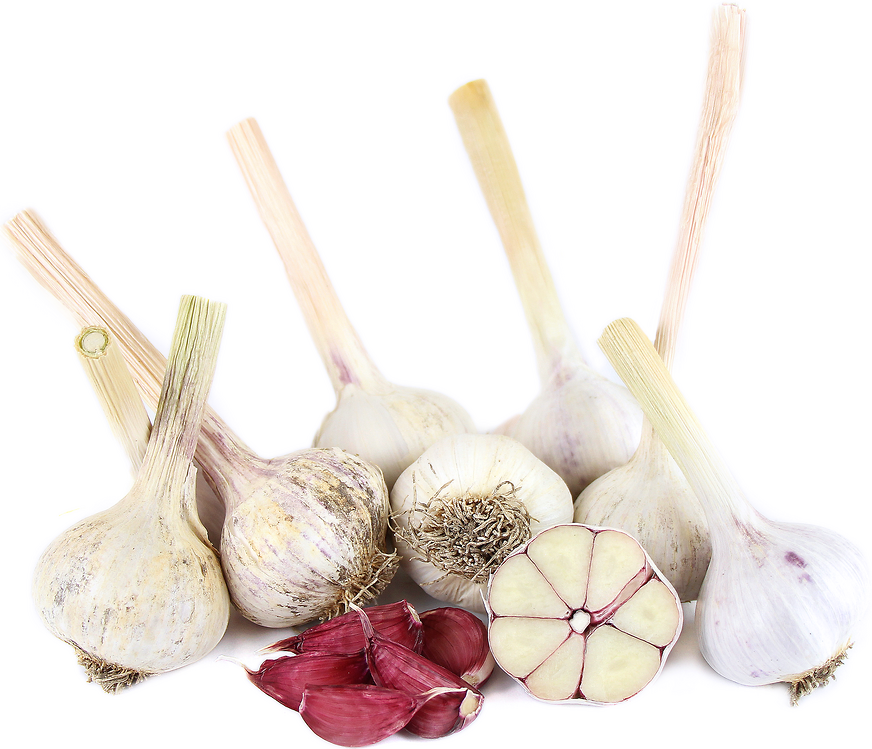


Purple Glazer Garlic
Estimated Inventory, lb : 0
Description/Taste
Purple Glazer garlic is a squat bulb, measuring up to 8 centimeters in diameter, with 6 to 10 very large cloves fitted around a central stem. The bulbs are wrapped in thin, bright white parchment-like coverings. Beneath the top layers, the easy-to-peel wrappers have a satiny, silvery finish and are streaked with purple and each layer removed reveals a more intensely purple hue. The individual clove covers range from a golden brown streaked with maroon to a lighter beige with only a few streaks of purple. The cloves have tips extending up to 3 centimeters long, a characteristic unique to this variety. Purple Glazer garlic is described as having a rich flavor that is mild with a hint of sweetness and no hot aftertaste. When cooked, Purple Glazer garlic may emit a distinct flavor similar to a leek.
Seasons/Availability
Purple Glazer garlic is available in summer through early winter.
Current Facts
Purple Glazer garlic, botanically classified as Allium sativum var. ophioscorodon, is a hardneck variety from Central Asia just west of what's known to experts as the "garlic crescent." It is a very visually appealing variety that has fewer, larger cloves than the more common garlic varieties. Known as Mchadijvari #1 in the Republic of Georgia, Purple Glazer garlic is one of a few cultivated varieties from the glazed purple stripe group of garlic. This group was named for their satiny, glazed wrappers and purple cloves and DNA studies have confirmed these characteristics to be unique to the group.
Nutritional Value
Purple Glazer garlic is an excellent source of B6, manganese, and vitamin C. It is also a source of copper, selenium, iron, and calcium.
Applications
Purple Glazer garlic can be used in both raw and cooked applications. It is most popularly enjoyed and known as a good baking garlic because its flavor will sweeten with roasting. Bake whole bulbs in the oven, wrapped in aluminum foil to trap the aroma. Purple Glazer can also be sliced or minced and used in pesto, garlic butter, or hummus. Add chopped or whole garlic cloves to soups and stews to add a mild, sweet flavor. Purple Glazer garlic pairs well with basil, oregano, ginger, soy sauce, and meats such as pork and poultry. Store Purple Glazer garlic for up to 10 months in a cool and dry location. Refrigerate any unpeeled or cut garlic for up to two weeks.
Ethnic/Cultural Info
Experts consider the Republic of Georgia to be a part of the "extended garlic crescent." At the end of the Cold War and the fall of the Soviet Union, American researchers were permitted to enter the region to confirm that the center of origin for garlic was Central Asia. Studies conducted on wild strains of garlic concluded that the center of origin for garlic was the Tien Shan mountain range located in western China and what is now Kyrgyzstan and Tajikistan. However, once the molecular research was done on wild strains of garlic, Georgia was included in the region and was dubbed as the "extended garlic crescent." This title is fitting as many dishes in the Republic of Georgia, including the popular chicken and garlic dish shkmeruli, calls for garlic as a staple ingredient.
Geography/History
Purple Glazer garlic is native to the Republic of Georgia, located in a region of Central Asia between the Black and Caspian Seas. It was first collected in 1986, from Mchadijvari, in the eastern central portion of the country. Outside of its native region, Purple Glazer garlic may be spotted at European farmers markets through small, local farms, or growing in home gardens.




